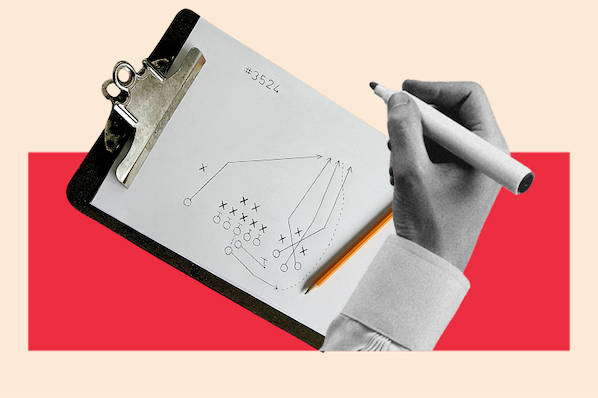Sales Process
Lessonly’s sales process has six stages:
- Meeting Scheduled: When an SDR assigns a meeting to an AE.
- Discovery: After the first conversation, when we’ve identified both a need for Lessonly, as well as a decision maker.
- Qualified: A prospect is qualified when they meet our internal criteria for authority (they have the ability to say yes), need (they have a good use case/need for our product), urgency (they can say yes within 60 days), and money (they can afford the product). The big jump between Discovery & Qualified is that they are serious about implementing a tool like Lessonly.
- Propose: When the AE has sent an official proposal to the prospect.
- Intent: When the AE has received a verbal commitment to sign. We ask for 90% or greater certainty from the AE.
- Closed: When the prospect has signed the deal.
Sales Team
Our SDRs are our evangelists. The hand-off to their AE occurs after the first meeting is booked. Right now, we have about 15 AEs and eight SDRs, along with a sales leadership team of four managers/directors.
Sales Cadence
We think talking about quantity of touches is an outdated approach to sales. Rather than quantity, we aim for quality -- we want to hit prospects at the right time, with the right touch, with the right information. While we offer our SDRs countless possible cadences to use, we don’t mandate anything -- we empower them to send what they think is best in a given situation.
Tactically, we do think about a 20-25 day cadence, with 4-5 calls and 6-7 emails across that window. But where we truly find success is offering our SDRs the autonomy to follow their gut and prioritize what they consider to be the best leads. When an SDR sees that a prospect is clicking on our emails and visiting our website, he or she spends far more effort on them versus someone who hasn’t opened any messages.
Another tool we keep in our SDR toolbelt is what we call one-off touches: Small, extra opportunities an SDR can leverage outside of a normal cadence. One of these is the non-footprint call. An SDR calls the prospect, hoping they’ll pick up -- but if they don’t, the SDR doesn’t leave a message. That way, we have more opportunities to get the prospect on the phone, but that prospect doesn’t feel overwhelmed. Other one-off touches include sending a LinkedIn invitation, writing handwritten notes, and sending personalized videos. It’s all about connecting in a human way with the prospect.
Outreach Email Template
We try to be customer-centric in our outreach. That means there’s a high level of customization in every outreach email. We start with an introduction appropriate to the industry, persona, or role. Then we add a highly relevant problem statement, and quickly convey how Lessonly solves the problem and adds value.
We conclude with an ask to get on the phone for 15-20 minutes to get to know one another, learn more, and/or brainstorm how we could work together. We also encourage creativity by our SDRs. As we see further engagement, SDRs might add a video or article that they think would be helpful to the prospect. Again, our goal is connection -- so we empower our team to send whatever they think will deliver value.
Connect Call
We are not trying to sell Lessonly on a first call. The most important thing is being human. The typical BDR has a one-track mind, and they will push and push until they get a meeting.
We don’t want to sound like your typical BDR when we get on the phone -- we want to really connect. It takes true business acumen to make this happen.
With that in mind, SDRs aren’t judged solely on volume, but the number of positive and real human connections they make. Sure, we’re interested in scheduling a meeting, but not at the expense of a relationship. A high-quality interaction will pay far greater dividends for Lessonly in the long run.
For example, you’ll hear a lot of BDRs pitch their product very early on in the call. It sounds something like: “Steve, I wanted to take 30 seconds of your time and tell you why my SaaS product is better and different from any others. It helped someone else like you improve X metric.”
At Lessonly, we want to sound like this: “Steve, I’ve been following ABC company for a while, and I noticed you recently wrote a post on their blog. Your ideas on improving culture were spot on -- I love learning about forward-thinking organizations like yours, which is why I gave you a call today.”
The tone is the most important aspect of this message. We want to sound genuine and the easiest way to do that is -- wait for it -- being genuine! We aim to have a heartfelt and energizing conversation with a prospect -- and weave in Lessonly as it connects to their interests and business.
Demos
Our SDRs schedule the demo for the AE, who runs the call. Again, customization is very important to us; since our customers are different, every demo is different. There is never any linear path through a demo. But generally, every demo opens with a verbal agenda so everyone is on the same page. We encourage our AEs to spend a significant portion of the call investigating the prospect’s needs -- that’s where the idea of asking good questions comes in.
The goal in any stage of our sales process is simple: Get to the next step. That might be a mutual agreement that Lessonly isn’t a great fit. It also could be a trial, or even a quick move to make a purchase.
Providing Value
Too often, sales processes feel selfish -- the rep on the phone just wants the prospect to buy their product. Instead, we would describe our sales process as selfless -- we want to honestly learn about the client and help them if we can.
That starts with great questions. We do a lot more listening on our calls than we do talking. We hear the challenges our prospects are facing, then offer stories of customers who have successfully addressed similar challenges.
We also want to provide real value to the buyer, whether they purchase our product or not. So we share best practices and thought leadership about where the best teams are moving. Our goal is that customers walk away feeling like they learned something from the call.
Final Thoughts
Altogether, our goal is to serve the prospect well. We want them to feel known, heard, and understood after talking to us -- real human connection is absolutely the secret sauce of our sales success.
Sales playbook






